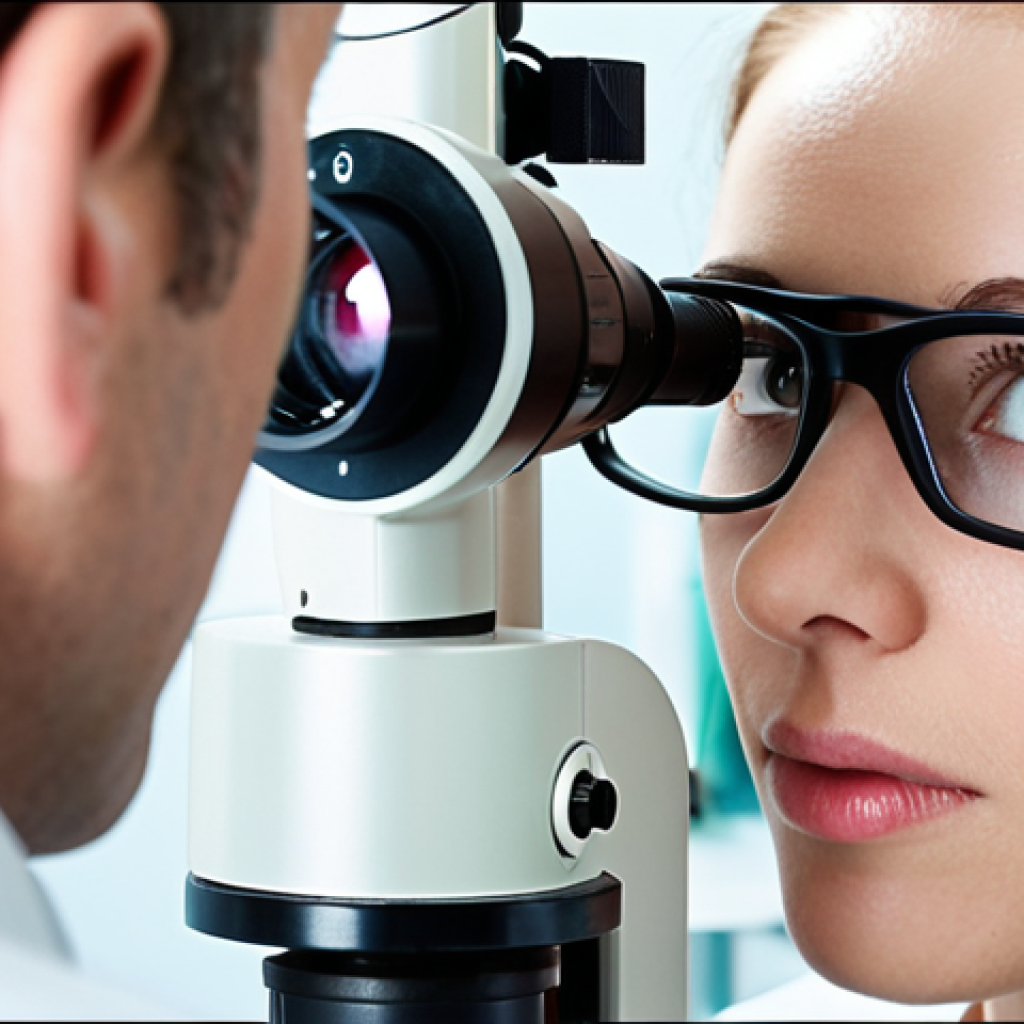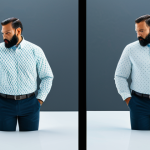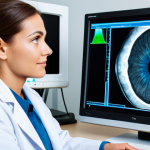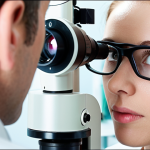When was the last time you really thought about your eyes? I mean, beyond just needing a new prescription for your glasses. As someone who spends way too many hours staring at screens, I know I’m guilty of taking my vision for granted.
But honestly, regular eye exams are so much more than just checking if you can see 20/20. They can be an early warning system for serious health issues, both related to your eyes and your overall well-being.
Think of it as a peek into your future health! Plus, with the rise of digital eye strain and potential long-term effects of increased screen time (a definite trend the experts are watching!), it’s more important than ever to stay proactive.
Let’s dive in and discover why these check-ups are non-negotiable. Let’s find out exactly why regular eye exams are so vital!
Alright, let’s get to it!
Decoding the Details: What Your Eye Exam Really Reveals

It’s easy to think of an eye exam as just a quick check to see if you need stronger glasses. But truly, it’s so much more than that. During the exam, your optometrist is carefully inspecting the various parts of your eye – the retina, the optic nerve, the lens, and even the blood vessels.
These structures can offer clues about your overall health, sometimes even before symptoms of a more serious condition become obvious. For instance, changes in the blood vessels in your retina can be an indicator of high blood pressure or diabetes.
And believe it or not, I actually had a friend whose optometrist noticed signs of a potential autoimmune disorder during a routine eye exam. It was pretty wild, and early detection made all the difference for her.
The Retina’s Revealing Secrets
The retina, that light-sensitive tissue at the back of your eye, is like a window into your circulatory system. Your optometrist can spot signs of damage from diabetes (diabetic retinopathy) or high blood pressure just by looking at the blood vessels there.
Glaucoma’s Silent Threat
Glaucoma, a condition that damages the optic nerve, often has no noticeable symptoms in its early stages. Regular eye exams are critical for detecting glaucoma early on, when treatment can be most effective in preventing vision loss.
This is especially important if you have a family history of the disease. My grandfather had glaucoma, and it was thanks to regular check-ups that he was able to manage it and preserve his vision for years.
Beyond Vision: Eye Exams as a Health Barometer
Here’s where things get really interesting! Your eyes can reveal surprisingly insightful details about your general health. During an eye exam, your doctor isn’t just checking your vision; they are examining the intricate network of blood vessels and nerves in your eyes, which can provide early warning signs of systemic diseases.
High blood pressure, diabetes, and even certain types of cancer can sometimes be detected through a comprehensive eye exam. I remember reading a story about a woman whose brain tumor was discovered during a routine eye exam – her optometrist noticed swelling of the optic nerve, which prompted further investigation.
Who knew your eyes could be such tattletales?
Spotting the Signs of Diabetes
Diabetes can wreak havoc on the blood vessels in your retina, leading to a condition called diabetic retinopathy. Regular eye exams can detect these changes early on, allowing for timely intervention and preventing vision loss.
Detecting High Blood Pressure
Similarly, high blood pressure can cause changes in the blood vessels of the eye, such as narrowing or bleeding. Your optometrist can spot these signs during an eye exam and refer you to your primary care physician for further evaluation.
The Digital Age: Why Screen Time Makes Eye Exams Even More Critical
Let’s face it: we’re all spending more time glued to our screens these days. Whether it’s working on a computer, scrolling through our phones, or binge-watching our favorite shows, our eyes are constantly being bombarded by digital devices.
This increased screen time can lead to a variety of eye-related issues, including digital eye strain (also known as computer vision syndrome), dry eyes, and even blurred vision.
Now, I know what you’re thinking: “Great, another reason to feel guilty about my screen habits!” But the truth is, it’s not about eliminating screen time altogether; it’s about being proactive and taking steps to protect your eyes.
Combating Digital Eye Strain
Digital eye strain is a common condition characterized by symptoms such as eye fatigue, blurred vision, headaches, and dry eyes. Regular eye exams can help identify and manage these symptoms, as well as rule out any underlying vision problems that may be contributing to the issue.
The 20-20-20 Rule and Beyond
Your optometrist can also offer practical advice on how to reduce eye strain, such as the 20-20-20 rule (every 20 minutes, look at something 20 feet away for 20 seconds) and proper workstation ergonomics.
Age-Related Changes: Protecting Your Vision as You Grow Older
As we age, our eyes undergo natural changes that can affect our vision. Conditions like cataracts, macular degeneration, and glaucoma become more common as we get older.
Regular eye exams are essential for detecting these age-related changes early on, when treatment can be most effective. My grandmother, for example, had cataracts removed in her early 70s, and it made a world of difference in her quality of life.
She was able to read, knit, and enjoy her hobbies again without struggling with blurry vision.
Cataracts: Clouding the Lens
Cataracts, the clouding of the eye’s natural lens, can cause blurry vision, glare, and difficulty seeing at night. Regular eye exams can detect cataracts early on, allowing for timely intervention and potentially preventing vision loss.
Macular Degeneration: Protecting Central Vision
Age-related macular degeneration (AMD) is a condition that affects the central part of your vision, making it difficult to read, drive, or recognize faces.
Regular eye exams can help detect AMD early on, when treatment can be most effective in slowing its progression.
The Importance of Early Detection for Children’s Vision
It’s so important to think about our kids’ eye health, too. Many vision problems that affect children can be easily corrected if they’re detected early.
But sometimes, kids don’t realize they’re having trouble seeing, or they may not be able to articulate their symptoms. That’s why regular eye exams are crucial for children, starting as early as infancy.
Early detection and treatment can prevent vision problems from interfering with a child’s learning and development. I volunteered at a local school doing vision screenings, and you wouldn’t believe how many kids were struggling with simple things like reading the board, all because they needed glasses.
Vision Screenings vs. Comprehensive Eye Exams
It’s important to note that vision screenings, often performed at schools or pediatricians’ offices, are not the same as comprehensive eye exams. Screenings can identify potential vision problems, but they don’t provide a complete evaluation of eye health.
The Link Between Vision and Learning
Vision problems can have a significant impact on a child’s ability to learn. Difficulties with reading, writing, and focusing can all be related to underlying vision issues.
Demystifying the Exam: What to Expect During Your Visit
Okay, so you know why regular eye exams are important, but what exactly happens during one? Well, first off, don’t be intimidated. The optometrist will start by asking about your medical history, any medications you’re taking, and any vision problems you’re experiencing.
Then, they’ll perform a series of tests to assess your visual acuity, depth perception, color vision, and eye muscle coordination. They’ll also use specialized equipment to examine the internal structures of your eyes, looking for signs of any health issues.
All in all, it’s a pretty thorough process, but it’s also relatively quick and painless. I remember being nervous before my first eye exam, but the optometrist was so friendly and explained everything clearly.
Common Tests and Procedures
Here’s a quick rundown of some common tests performed during an eye exam:
Visual Acuity Test
Using an eye chart to measure how well you can see at different distances.
Refraction
Determining your eyeglass prescription using a phoropter.
Slit-Lamp Examination
Examining the structures of the eye under high magnification. Here is a table that illustrates the importance of regular eye examinations.
| Age Group | Recommended Frequency | Key Benefits |
|---|---|---|
| Infants and Toddlers | As recommended by pediatrician | Early detection of congenital eye conditions |
| Preschool Children | At least once between 3 and 5 years old | Identify vision problems that can affect learning |
| School-Age Children | Every 1-2 years | Ensure optimal vision for school performance |
| Adults (Under 40) | Every 2 years (or as recommended) | Monitor vision and detect early signs of eye diseases |
| Adults (40-60) | Every 1-2 years | Check for age-related changes, such as cataracts and glaucoma |
| Adults (Over 60) | Every year | Monitor eye health and detect age-related eye diseases |
Debunking the Myths About Eye Exams
Let’s clear up some common misconceptions, okay? *Myth: Eye exams are only for people who wear glasses. *Myth: If my vision seems fine, I don’t need an eye exam.
*Myth: Eye exams are expensive and time-consuming. *Myth: Eye exams will hurt.
Making Eye Health a Priority: Practical Tips for Healthy Vision
Okay, so hopefully, I’ve convinced you that regular eye exams are a non-negotiable part of your overall health routine. But what else can you do to protect your vision?
Well, for starters, make sure you’re eating a healthy diet rich in fruits, vegetables, and omega-3 fatty acids. These nutrients are essential for maintaining healthy eyes.
And of course, don’t forget to protect your eyes from the sun by wearing sunglasses that block 100% of UV rays. Finally, give your eyes regular breaks from screen time, and practice good eye hygiene by washing your hands before touching your eyes.
The Role of Nutrition in Eye Health
Certain nutrients, such as vitamins C and E, zinc, and lutein, have been shown to protect against age-related eye diseases.
The Importance of UV Protection
Exposure to UV radiation can increase your risk of cataracts and macular degeneration.
Investing in Your Future Vision
Ultimately, regular eye exams are an investment in your future vision and overall well-being. By detecting potential problems early on, you can take steps to protect your eyes and maintain clear vision for years to come.
I think we can all agree, that’s an investment worth making! Don’t wait until you’re experiencing vision problems to schedule an eye exam. Make it a part of your routine, and prioritize your eye health.
Your eyes will thank you for it! Alright, here’s the conclusion and additional sections you requested:
Wrapping Up
So, let’s make eye health a priority! Regular check-ups aren’t just about updating your prescription; they’re vital for catching potential health issues early. Schedule that appointment, wear those sunglasses, and give your eyes the love they deserve. Here’s to clear vision and a healthier future!
Handy Information to Keep in Mind
1. The 20-20-20 Rule: Every 20 minutes, look at something 20 feet away for 20 seconds to reduce eye strain.
2. Eat a colorful diet rich in fruits and vegetables to get essential eye-healthy nutrients.
3. Wear sunglasses that block 100% of UVA and UVB rays to protect your eyes from sun damage.
4. If you work at a computer, adjust your monitor and seating for optimal ergonomics.
5. Schedule regular eye exams based on your age and risk factors, as recommended by your optometrist.
Key Takeaways
Regular eye exams are about more than just vision; they’re a window to your overall health. Early detection of eye conditions and systemic diseases is crucial for timely intervention and prevention. Protect your eyes with a healthy lifestyle, UV protection, and by following the 20-20-20 rule for screen time.
Frequently Asked Questions (FAQ) 📖
Q: Okay, so what’s the big deal? I can see fine, why bother with an eye exam if my vision seems okay?
A: You know, that’s exactly what I used to think! But turns out, your eye health is about way more than just whether you can read the eye chart. An eye exam can detect early signs of conditions like glaucoma or macular degeneration, which often have no symptoms in their early stages.
My uncle found out he had glaucoma during a routine exam, and catching it early made a huge difference in his treatment and preserving his vision. Plus, things like high blood pressure and diabetes can actually show up in your eyes before you even know you have them!
So think of it as a sneak peek into your overall health. It’s really not just about seeing clearly.
Q: How often should I actually be getting my eyes checked? Once a year? Every few years?
A: That’s a good question, and it honestly depends on your age and risk factors. Kids and older adults definitely need more frequent exams, but for most adults, every one to two years is generally recommended.
If you have a family history of eye disease, diabetes, high blood pressure, or spend a lot of time staring at a screen (like most of us!), you might want to go more often.
My optometrist recommended yearly check-ups for me because of my family history of macular degeneration and, let’s be real, my addiction to Netflix. Best bet?
Chat with your eye doctor to figure out what’s right for you.
Q: What exactly happens during an eye exam? Is it just reading letters on a chart?
A: Nah, it’s way more involved than just squinting at letters! Of course, they’ll check your visual acuity with the eye chart, but they’ll also do a bunch of other tests.
They’ll check your eye pressure to screen for glaucoma, examine the back of your eye (the retina and optic nerve) for any signs of disease, and assess your peripheral vision.
They might even use dilating eye drops, which make your pupils bigger so they can get a better look inside your eye – that can make you a little sensitive to light for a few hours, so bring sunglasses!
Honestly, I was surprised at how thorough it was the first time I went. It’s a pretty comprehensive check-up for your peepers!
📚 References
Wikipedia Encyclopedia
구글 검색 결과
구글 검색 결과
구글 검색 결과
구글 검색 결과
구글 검색 결과





